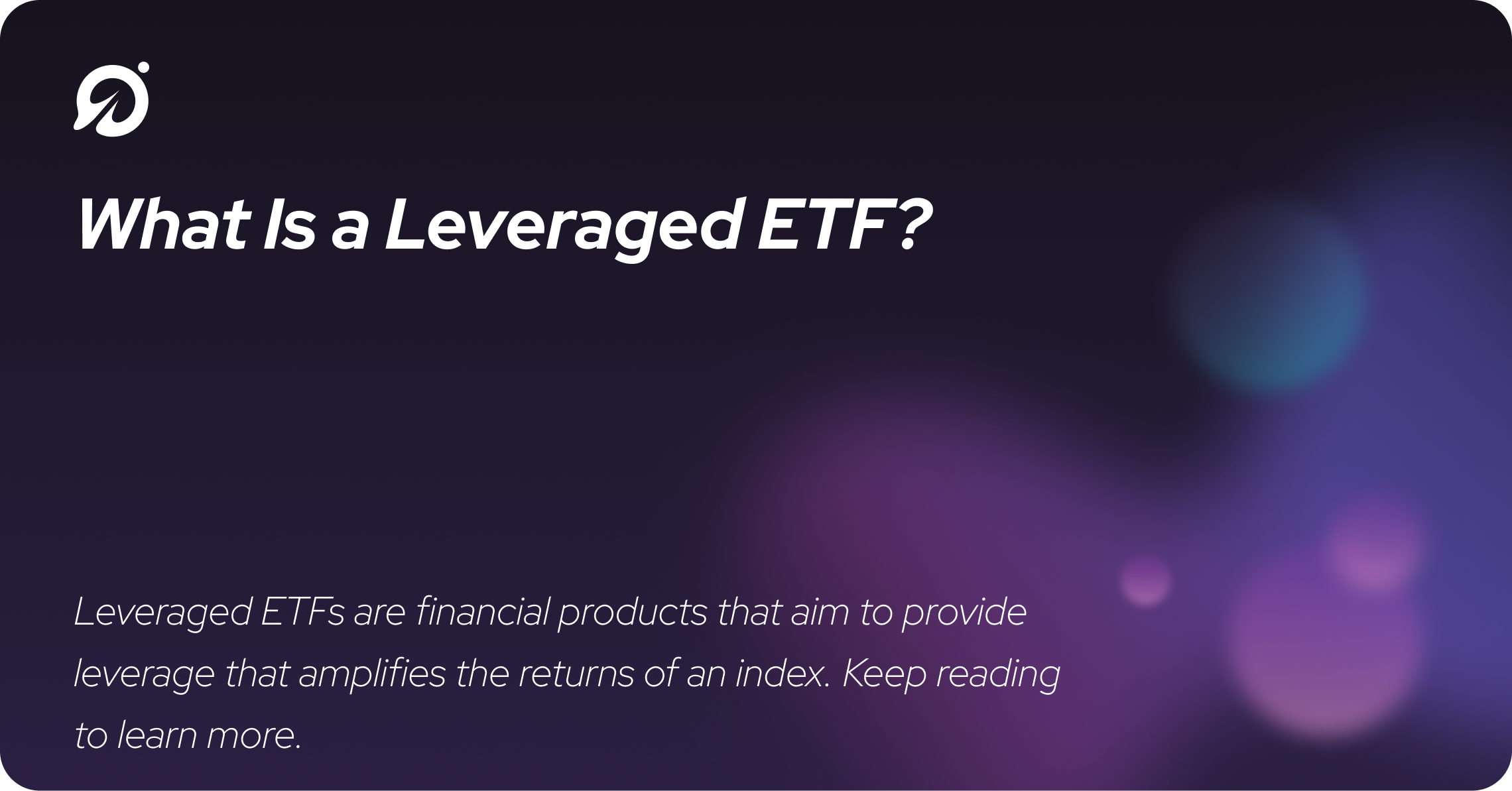What Is a Leveraged ETF?
Learning more about leveraged ETFs can help you level up your crypto portfolio. Read on as Pluto dives in.

Disclaimer: This is for informational purposes and is not meant to serve as financial or investing advice.
What Is a Leveraged ETF?
A leveraged exchange-traded fund (ETF) is a security on the stock market that uses derivatives and leverage to amplify exposure to an underlying index, such as the Nasdaq 100.
Usually, ETFs represent a one-to-one exposure of the fund’s underlying assets. A leveraged ETF can increase that exposure to 2x or 3x. They are intended to be traded intraday and not to be held for longer terms.
For example, the main S&P 500 index is an index of 500 large companies trading in the United States. A 3x leveraged S&P 500 index grants you exposure to 3x the returns of those companies' stock.
You would use a trading product like an S&P 500 ETF when you are bullish on the short-term price movement of the market. Leveraged ETFs are designed to be held for short periods of time, and it’s not advisable to keep these over the long term.
Inverse Leveraged ETFs
An Inverse leveraged ETF uses derivatives to allow you to take a short position against the benchmark index. If you are in a bear market or the underlying assets of an ETF, this is an instrument to capitalize off your thesis.
Inverse leveraged ETFs are complex instruments that are difficult to formulate and manage. Schwab estimates that more than half of all created inverse leveraged ETFs have been liquidated.
There are even inverse leveraged ETFs for specific stocks like Tesla. Maintaining the leverage ratio of an inverse ETF is challenging, so these products are uncommon compared to regular leveraged ETFs.
Double and Triple Leveraged ETFs
Double and triple-leveraged ETFs amplify profits 2x or 3x. Let’s take a 3XNASDAQ ETF, for example. If you bought one share of the NASDAQ and it increased by $10 in price, you would gain $10 on paper.
Now, if you bought one 3xNASDAQ ETF and the NASDAQ increased $10 in price, you would book $30 in gains.
Most leveraged ETFs have a 2x or 3x leverage ratio. It’s essential to check what leverage an ETF has before you invest, as the difference between leverage ratios has a considerable effect on trade outcomes.
How Do Leveraged ETFs Work?
Traditional ETFs are highly regulated products backed by derivatives, futures contracts, options, and swaps. Leveraged ETFs must be frequently rebalanced to maintain a 2x or 3x leverage ratio.
These rebalances use daily returns to reinvest in the underlying assets. This means daily gains of leveraged ETFs are compounded.
In crypto, there are also leveraged products that index a leveraged position but aren’t composed of the underlying assets.
These products trade on the blockchain and aren’t registered financial products like traditional ETFs. Tokensets is one excellent example of how on-chain index funds are created.
What Are the Advantages of Leveraged ETFs?
1. Can Outperform Market Index
If you are bullish on the short-term performance of an asset, it’s a no-brainer to amplify the gains of your LTF trades with a leveraged ETF.
If the underlying benchmark increases by 10%, a 2x ETF will increase by 20%.
Over time you can use low time frame trades and leveraged ETFs to outperform benchmark indexes by more than 2x or 3x.
Leveraged ETFs for specific sectors are great for events-driven trades. For example, if Boeing earnings are coming out today and you think they would outperform, you could buy an ETF that leverages the JETS, a popular airline index.
2. Wide Variety
Leveraged ETFs cover a wide variety of assets. You could invest in something as wide as a market-wide index or as drilled down as a leveraged AMZN index.
When you’re developing your trading system, taking note of leveraged products for assets you plan to trade intraday can be helpful.
Diversified allocation strategies allow you to hedge downside risk. Leveraged ETFs enable you to amplify returns across many different asset classes.
3. Can See Gains in Down Market
It depends on timing but buying a leveraged ETF during a down market can allow you to make significant returns from tiny price reversals. Leveraged ETFs amplify the downside return of the index, so it can be risky to trade these during a market downturn.
What Are the Risks of Leveraged ETFs?
1. Underperforming Market Index
Depending on how the ETF is formulated, you risk underperforming the market by investing in a leveraged ETF.
Because gains are amplified, so are drawdowns. This can keep leveraged ETFs in the negative while regular indexes make gains. This makes leveraged ETFs a high-risk investment, which may or may not align with your investment objectives.
You can read more about trading leveraged products on the Pluto blog.
2. Can Be Expensive
Always look for a fee when investing in a leveraged ETF. ETF issuers spend resources managing ETFs on behalf of investors, and in exchange, they take a percentage of your capital as a fee. Expense ratios for leveraged ETFs can be as high as 1%.
Leveraged ETFs that are rebalanced daily also incur greater frees than regular benchmarks. Another drawback to frequent rebalancing is that it can incur capital gains taxes.
Portfolio managers of mutual funds employ strategies to offset capital gains and reduce the customer’s tax burden. Mutual funds can be considered a substitute product for leveraged ETFs.
3. Poor Long-Term Investment
Leveraged ETFs tend to underperform their underlying components in the long term. The price of the ETF decay relative to its assets. This is because leverage and volatility don’t mix. The investing terminology for this effect is called “volatility decay.”
Consider this alarming example of 3x ETF performance from Investopedia. If a benchmark index increases 5% one day and decreases 5% the next, a 3x leveraged ETF would increase 15% and then fall 15%.
In practice, this means $100 would increase to $115 and then decrease to $97.5. Remember, the benchmark asset is flat, and you are down 2.25%.
This is why leveraged ETFs are best for short-term directional trades and not long-term holds. Leveraged ETFs are especially bad to hold during volatile markets.
If you’re interested in learning more about trading with leverage, you should read the Pluto guide to leverage next.
Can You Invest in Crypto Leveraged ETFs?
In the United States, there aren’t any regulated leveraged ETFs in crypto. Grayscale Bitcoin Trust (GBTC) is probably the most well-known crypto ETF.
The SEC even prevents crypto ETFs from being composed of actual cryptocurrency. ETF issuers have to use derivatives and equities to index the underlying crypto synthetically. In some cases, crypto indexes hold shares of crypto-friendly tech companies.
The SEC has recently denied proposals for leveraged crypto ETF products. There are ways to invest in Crypto Leveraged ETFs. Like Tokensets, which we mentioned earlier, some on-chain products offer leveraged crypto products.
It is a very controversial decision for the SEC to continue to deny these products. Financial companies like Grayscale constantly push the government to allow new crypto ETFs.
There is significant consumer demand for tradeable crypto products. In the financial community, it is a recurring joke that crypto products are declined by the SEC. Right now, it seems like a futile effort.
Decentralized perpetual exchanges like GMX and DYDX also offer leveraged crypto products. Unfortunately, these platforms are prohibited for U.S. citizens.
There are also many ERC20s trading on the Ethereum blockchain that act as leveraged crypto ETFs. But these tokens can quickly implode due to market conditions and low liquidity.
The Bottom Line
Leveraged ETFs are a specialized tool used for short-term investing strategies. The ETFs amplify the returns of the benchmark index.
Leveraged ETFs allow beginner investors to trade with leverage like they would trade common equities or tokens. Inverse ETFs can also be useful for shorting indexes with leverage.
U.S. financial regulators have so far hampered efforts to create leveraged crypto ETFs. Smart contracts have allowed leveraged indexes to be created on-chain as tradeable tokens. Crypto users can log in and buy them with their crypto wallets.
Before trading with leveraged ETFs, you should understand the underlying assets that make up the fund and the fees charged to the investor.
Pluto is a one-stop platform for creating automated equity and crypto trading strategies. You can use our community-created techniques to outperform indexes.
Sources:
Leveraged ETFs: The Potential for Bigger Gains—and Bigger Losses | Investopedia
Why 3x ETFs Are Riskier Than You Might Think | Investopedia
Leveraged Bitcoin ETFs? SEC To Deny Valkyrie’s Proposal | Yahoo
Leveraged and Inverse ETPs: Going, Going, Gone? | Schwab.com
